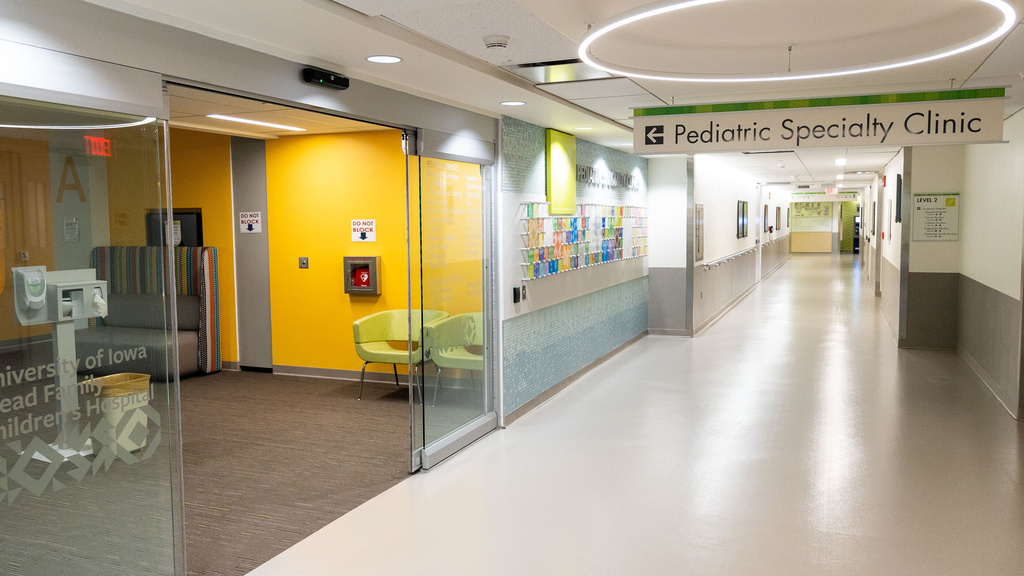Main navigation
The Division of Pulmonary Medicine cares for infants and children with respiratory needs from the entire state of Iowa, the Midwest, and beyond in the inpatient and outpatient setting.
Our fellowship is structured to emphasize clinical learning in the first year and prioritize protected time for research and career development in the second and third years.
Fellows will care for children with Cystic Fibrosis (CF), Asthma, Bronchopulmonary Dysplasia (BPD), Chronic Respiratory Insufficiency and Technology Dependence, Aerodigestive Disorders, Childhood Interstitial Lung Disease (chIlD), Sickle cell related lung disease, sleep disorders, and other pulmonary diseases and breathing disorders of infancy, childhood, and adolescence.
We have multi-disciplinary teams involved in the care of many of our patients, including CF, Aerodigestive, and severe BPD. All CF patients are reviewed and discussed during a weekly interdisciplinary team meeting. The interdisciplinary LUNG team meets weekly in the NICU to discuss patients with severe BPD who have tracheostomy and ventilator dependence. Our Aerodigestive program has clinic once per month and has team members from Pulmonology, GI, ENT, and Speech therapy. While rotating on the inpatient service, the fellow is responsible for the care of all patients admitted onto the pulmonary service on the general wards and in the intensive care units of the hospital with support from the attending pediatric pulmonologist. Rounds are made daily with a designated inpatient faculty member, at which time the plan of care is reviewed.
In outpatient clinic, fellows get exposure to all respiratory pathologies both in their own continuity clinic and in our subspecialty clinics. This includes robust experiences with pulmonary function testing (spirometry, lung volumes, diffusion, impulse oscillometry, and cardio-pulmonary exercise testing). There will also be opportunities to spend time with sleep medicine, ENT, GI, Cardiology, and at our outreach clinics. Diagnostic evaluation of inpatients and outpatients is supported by a well-equipped flexible bronchoscopy facility. You will get plenty of opportunities to perform flexible bronchoscopy, and this can also include exposure to more advanced techniques like cryoprobe usage and cryo-biopsy.
Year 1
Approximately 18 weeks of call. When on call or “on service,” fellows run the inpatient and consult teams with an attending. This includes taking night call for the entire week. When not on service, fellows will have their weekly continuity clinic plus 3-4 additional half days of subspecialty clinic to attend. There is dedicated time to identify mentors, a scholarly oversight committee, and pick a research project for your fellowship.
Years 2 and 3
Approximately 6-8 weeks of call. When not on service, fellows will have only their weekly continuity clinic. All remaining time is dedicated to research and career development activities. If a fellow is more interested in a clinical career, there is plenty of flexibility to add more clinical experiences.
Facilities

University of Iowa Health Care Stead Family Children’s Hospital
The new, approximately $360 million, 507,000-square-foot Stead Family Children’s Hospital facility opened in February 2017. Adjacent to the University of Iowa Health Care Medical Center, the 14-level structure (12 above ground, 2 below ground) has 183 beds and eight pediatric operating rooms as well as features that focus on the needs of patients and their families.

PICU
Our 28-bed Pediatric Intensive Care Unit (PICU) and Pediatric Cardiac Intensive Care Unit (PCICU) is the only comprehensive health care center in Iowa that offers the full range of pediatric critical care therapies. We have the people, the expertise, the experience, and the state-of-the-art equipment and facilities to provide the highest level of care for a wide range of complex, and sometimes rapidly changing, medical problems.

NICU
Our Neonatal Intensive Care Unit is the only NICU in Iowa to have a Level IV designation, which is the highest level recognized by the American Academy of Pediatrics. This means that we care for the tiniest and most critically ill babies, offering the greatest range of neonatal services and support. The state-of-the-art NICU houses up to 81 critically ill newborns, all in single rooms with four larger rooms that will accommodate twins. The unit is equipped with the latest equipment and staffed by a large team of highly trained nurses and other staff. A laboratory within the NICU provides around-the-clock service.

Pediatric Specialty Clinic
Our clinic is at located at Stead Family Children's Hospital where patients and their families enjoy the ease of access. The proximity to other pediatric subspecialties as well as pediatric providers of other specialties allows us to collaborate with these providers when needed and coordinate care for our more complex patient populations.
